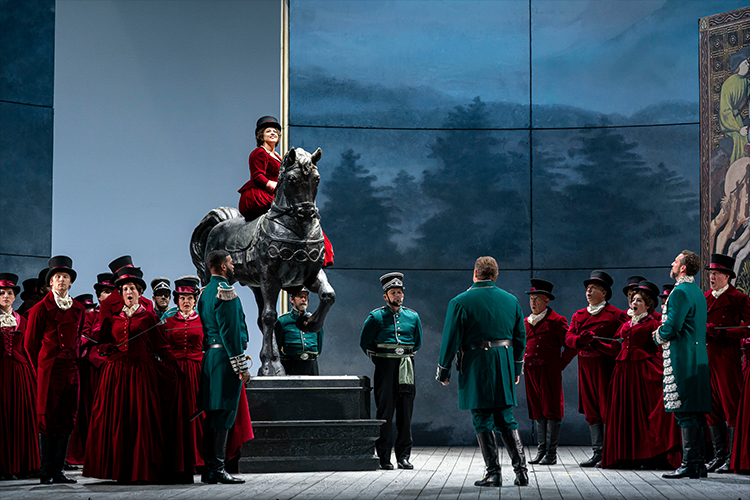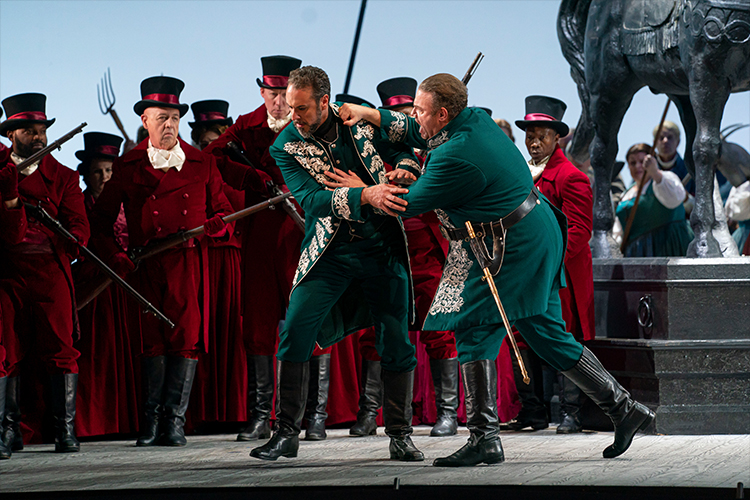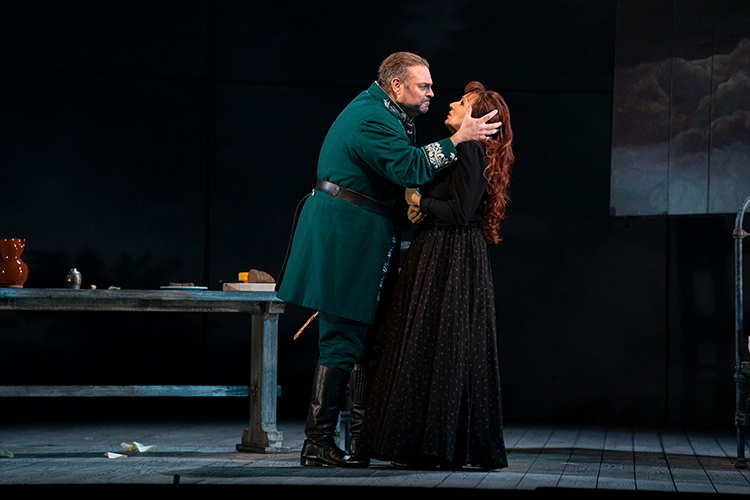October 11, 2019
LUISA MILLER: Verdi Looks to The Future
There are memorable heroines in Giuseppe Verdi’s early operas, but Luisa Miller is the only one who will make you cry. In the entire opera, Luisa has just one moment of happiness. Once her sparkling, ecstatically lovestruck opening aria is over, the plot leads her on a harrowing path of sorrow and betrayal. We feel for her at every moment, and by the end she’s wrenched our hearts to a degree few other operatic leading ladies can match. Audiences owe Verdi a huge debt of gratitude for that unforgettably touching characterization, and indeed, for all the other strengths of this work that make it a glorious experience in the opera house.
Luisa Miller presents a Verdi who at the time (1849) was in his mid-thirties and finally on the brink of fulfilling all his gifts as an incomparable creative artist. If you’re just beginning to explore this opera and others from the first decade of his career, you have spectacular adventures ahead, for the vocal thrills run high, the emotions deep. The wealth of stupendous music illuminates stories that exude white-hot passion and rich humanity
To his audiences, the Verdi of Luisa Miller had already demonstrated extraordinary talent (he had 14 operas under his belt), so they knew to expect high-quality work from him. While his previous operas hadn’t all been equally triumphant, the greatest of them – Nabucco, Ernani, and Macbeth – had shown everyone that he was capable of profoundly thoughtful, meaningful music drama. The feelings communicated by all his protagonists reached out to the public with a vividness and an immediacy that were unique.

Act One: Duchess Federica arrives at Walter’s castle
When the circumstances of a premiere were comfortable for him (not always the case), Verdi was able to relax and work with a certain confidence. From the very start, though, he was never, ever satisfied; like Gaetano Donizetti before him, he often tortured himself with worry, doubt, and frustration, especially when he didn’t get the singers he wanted for a premiere or a major revival. Through and through he was a man of the theater, and serving the theatrical side of a work was always as crucial to him as musical excellence. Even in the early years, whenever he supervised a production, he insisted on total dedication from the artists and could never rest until a scene was right (the story was told by the first Lady Macbeth that he rehearsed her big duet with the leading man 150 times). By the 1840s he was gaining increasing respect in Italy as someone who represented in every way a new standard – a new vision – of what opera was meant to be onstage.
Luisa Miller exemplifies everything that makes the earlier operas of Verdi so exciting for audiences. This work comes at the tail end of Verdi’s self-named “galley years,” when he was perfecting his craft and gradually finding his way as a musical dramatist. But Luisa Miller is also at the same time a transitional piece, a bridge connecting Verdi’s early operas with the mastery of what he would produce just a few years later. In Luisa Miller listeners can relish the vigor and tunefulness of Rigoletto, a dramatic fire anticipating Il trovatore, and a tragic romance reminding us that La traviata was soon to come.

Act Three: Miller (Quinn Kelsey) comforts his unhappy daughter Luisa (Krassimira Stoyanova)
If you know the most dramatic works of Verdi’s nineteenth-century predecessors, the early operas will sound familiar to you. From the very beginning (his “debut” was Oberto, premiered in 1839), Verdi imported the rhythmic energy that characterized the operas of Rossini, although on a grander scale. And he employed other basic components that were absolutely essential to Rossini, Bellini, Donizetti, and all the other Italian composers of the time: the opening choruses, the large-scale finales, and above all, the central ingredient of those operas – the solo scena. This is the audience’s most important opportunity to get to know a principal character, giving us an in-depth look into that character’s soul. That happens through the linking together of several different musical elements to form a vivid, totally memorable scene.
As heard in Luisa Miller, what makes a “scena”?
- Opening recitative – through what is essentially sung speech, a dramatic situation is established.
- Cavatina – the character sings a dignified, slow, legato-oriented aria, expressing his/her emotional state at that moment.
- Connecting recitative – the situation develops further, usually with a new discovery for the character, leading to a change of heart or an important decision.
- Cabaletta – the character responds with a faster, much more driving and aggressive aria than the cavatina, with the music generally including some moments of vocal fireworks.

Act Two: Now that Rodolfo (Joseph Calleja) has lost Luisa, he doesn’t care what fate may bring to him and Walter (Christian Van Horn)
Emotional communication in the earlier Verdi operas was direct, unfussy, and basic – painting with primary colors, so to speak. The dramatic content also related to royalty and nobility. There were several real-life personalities, from the Babylonian king Nebuchadnezzar in Nabucco to Joan of Arc in Giovanna d’Arco, King Charles V of Spain in Ernani, and Doge Francesco Foscari of Venice in I due Foscari. But in Luisa Miller, Verdi took a different turn: referring to Luisa and her father, the critic Andrew Porter succinctly declared that the opera “reflects Verdi’s new concern with ‘ordinary’ – but interesting – people in interesting predicaments.”
The great difference between where the composer began with his first operas and where he arrived in Luisa Miller can be summed up by Verdi’s contemporary, Abramo Basevi, Italy’s most distinguished musicologist of that time. He labeled pre- and post-Luisa Miller as Verdi’s “first manner” and “second manner.” The first manner was dominated by “the grandiose,” whereas in the second manner, “the grandiosity decreases, even vanishes: every character stands only for himself; and because the emotions belong to individuals, they have less need of exaggeration; hence the vocal lines, however impassioned, proceed more calmly. The melodies are lighter and less broad, the rhythms more fluent and less involved.”
Luisa Miller almost didn’t happen. Verdi had a longstanding contract to write a new opera for Naples’s prestigious opera house, the Teatro San Carlo. He tried to cancel the contract, but the San Carlo’s resident librettist, Salvadore Cammarano, begged Verdi to fulfill his obligation. After the composer’s initial idea for a subject was rejected by the censors, Cammarano suggested that the two of them take on a play by Friedrich von Schiller. Verdi hoped to create what he described as a “brief drama with plenty of interest, action, and above all feeling – which would all make it easier to set to music.” Extravagantly devoted to the works of Schiller, Verdi used them as his dramatic sources for three other operas – Giovanna d’Arco (1845), I masnadieri (The Bandits, 1847), and Don Carlos (1867).
Luisa Miller originates with Schiller’s Kabale und Liebe (1784), a title often translated as Love and Politics but more accurately Intrigue and Love. Only the absolute essentials of the play were kept for the libretto. The 12-character cast required some major consolidating to create a three-act opera in which the typical operatic conventions of Verdi’s day could be employed.
This drama unfolds through music that seems at every moment miraculously attuned to character, not always the case in Verdi’s early operas. The sweetest and most loving of heroines, Luisa moves from the dazzling staccatos and filigree of her captivating entrance aria (a reminder that Rigoletto’s Gilda was only two years in the future) to the sweeping, despairing, grand-scale lines of her scena in Act Two. Then, in Act Three, she faces one of the toughest tests posed to any Verdi soprano: two huge duets and a trio, sung without a break. In the first duet, with Miller (baritone), she moves from misery to hope while negotiating music requiring the absolute ultimate in technical prowess. The second duet, with Rodolfo (tenor), asks her to plumb the most agonizing emotional depths in music that turns increasingly weighty and dramatic as it proceeds. Then finally, in the concluding trio, when the dying Luisa asks for her father’s blessing, Verdi gives her a sequence of luminous, exquisitely sculpted phrases that could draw tears from a stone.

Act Three: Rodolfo (Joseph Calleja) believes Luisa (Krassimira Stoyanova) has betrayed him
Rodolfo, too, has his scena, featuring a cavatina that, when it comes to Verdi tenor solos, is second in popularity only to the Rigoletto Duke’s “La donna è mobile.” Once he’s sung that fervently nostalgic cavatina, Rodolfo must turn up the dramatic voltage in the barnstorming cabaletta: stunned by Luisa’s supposed betrayal and with a loveless marriage to Duchess Federica looming ahead, he gives way to reckless defiance in music that the eminent Verdi scholar Julian Budden aptly described as “almost demented.”
Miller’s big solo scene in Act One gives the baritone opportunities for excitingly broad, surging phrases, but Verdi asks him for more soul-searching, more profoundly expressive singing in the Act Three duet with Luisa. Here is a baritone/soprano scene that, in terms of sheer eloquence, can absolutely stand comparison with the three father-daughter duets in Rigoletto as well as the Germont/Violetta scene in La traviata. Count Walter, a somewhat softer, less vicious figure than in Schiller’s play, is at his most imposing in his scene with the despicable Wurm. They give us a true rarity in opera – a duet for two basses. And then there is Federica, not a character with huge dramatic interest but one who can rejoice in warmly alluring contralto tone.
This opera’s choral episodes aren’t as abundant or as lengthy as those of two better-known early Verdi works, Nabucco and Macbeth, but those scenes nonetheless contribute notably to the crackling theatrical atmosphere. If you want the thrill of largescale Verdi, you need only listen to the Act-One finale: Miller’s violent opening phrases, the passionate responses of Rodolfo and his father, Luisa’s soaring line above the men, and then – at precisely the right dramatic moment – the magnificent choral intervention supporting Luisa’s despairing phrases.
By comparison to what we hear from Verdi earlier in the 1840s, it’s Luisa Miller alone that shows him at a crossroads. About to reach his absolute zenith, he’s building on what he learned from Rossini, Donizetti, and the rest, but also pointing the way forward to his own glorious operatic future.
